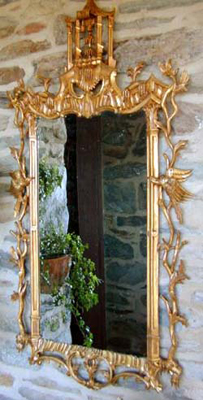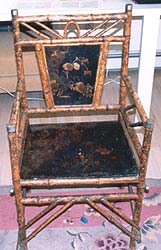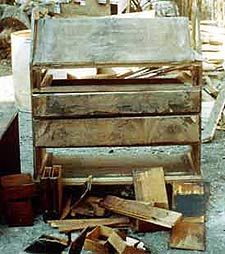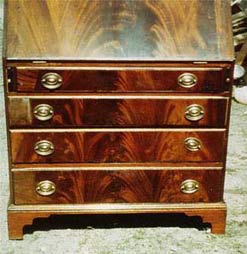
The “Gilded Age,” a term coined by Mark Twain to describe the period from the 1870s to World War I, was characterized by “robber barons” who amassed enormous amounts of wealth during the Industrial Revolution. They spent lavishly on themselves and their friends in spite of hard times throughout the nation. One restaurant hosted horseback dinners for the New York Riding Club, and at a time when the average income was less than $500 per year, Mrs. Stuyvesant Fish once threw a dinner party to honor her dog. The dog arrived wearing a $15,000 diamond collar.
Some of the richest of the rich used their tax -ree money to build replicas of European palaces, many in Newport, Rhode Island, and furnished them with fine antiques collected during “grand tours” of the Old Country. The region was also a mecca for the 19th century China trade, which brought many Oriental pieces into the area. As a consequence, many of the finest and most valuable antiques in the nation are in Newport, and that’s where you will also find Stephen Rosasco.
For the past 33 years, Rosasco, a professional furniture and decorative arts conservator and restorer, has been working on some of the best of Newport’s collections.”I was in college studying liberal arts,” he told me,”and a friend’s mother showed me some repairs she had done on an antique. I was so intrigued with the repair, that I decided that was what I wanted to do. A year later, I moved to Newport.”
Newport has a large number of intact 18th century houses, many of which are full of original furniture. As a consequence, conservators and restorers are in great demand.”The people who built these furnishings learned the trade in the apprenticeship system,” Rosasco explained,”and had many years’ experience before they did any work. To restore these pieces, one has to have similar skills and training. For example, it is a lot harder to restore a piece than it is to build it. To repair a piece, it often must be dismantled. To do that, you must know how it was assembled. The only way to do that is to have done it.”
“When it comes to antiques,” Rosasco continued,”what you don’t do is often more significant than what you do. Years ago, people soaked everything in linseed oil. Now, we are more aware of only using things that are reversible, such as shellac and lacquer. Whatever I do, I keep an eye toward the future. The history of the piece is still happening.”

“I think Antiques Roadshow has done a great service to antiques and to the profession. They have educated both owners and restorers regarding how important condition is. People now realize that the ideal is to have a piece in original condition. Unfortunately, it is rare for a 250-year-old piece to be in its original condition. In some instances, poor repairs should be reversed, and that includes some inappropriate finishes, but in other cases, the best thing to do is preserve what is there. For example, if a piece was refinished in the 19th century, that is now part of the history of the piece and should be left intact.”
I asked Stephen what should, and should not, be done by owners of antiques, and he responded with a sizeable list of do’s and don’ts.”Pieces should be cleaned and waxed with regular paste wax once a year. Avoid polishes with silicone oil, since the oil can go through old finishes and impregnate the wood, which can make future refinishing difficult. Furniture should be kept out of the sun, and out of traffic patterns. If you have to walk around it, you’ll walk into it, which does little good for either you or the piece.
“Keep pieces away from heating elements. Try to regulate the temperature and humidity of the room in which the pieces live. The ideal is 70 degrees and 50 percent relative humidity. Don’t set plants or vases directly onto a table. These can cause water to sit on the finish and damage it. Avoid hot cups or carafes on a finish, and avoid writing directly on a finished surface. Use pads on tables to prevent all of these assaults. Also avoid putting excessive weight on a piece as it can stress the joints, and don’t sit on a chair if you are larger than what the piece was designed to support.
“How you move antiques is also important. When you move a table, lift it by the apron, not by the top. Grab chairs by the seat frame and the back, and not just the back. Inspect the structure of the piece periodically, and if something starts to become loose or unstable, contact a professional conservator or restorer. It is best not to attempt repairs yourself. It’s not just the skills; it also involves using the right materials.”
Since Rosasco calls himself a conservation restorer, I asked him to explain the difference between conservation and restoration.” Conservation is a preservation tool,” he said.”With conservation, it is more important that the object be preserved than functional. Museums use conservators. Restoration means bringing an object to a previously functional condition, including restoring the aesthetics. In the case of a finish, for example, that may go from merely cleaning it to refinishing it. While conservation is a holding pattern, restoration is a reversing one.
“A restoration might involve replacing a leg, for example, but conservation generally would not. Instead, the conservator would repair it using the original materials as much as possible, even if that rendered it only appropriate for very limited use. But even in the case of a restoration, the original broken leg would be kept with the piece. If it ever went into a museum, the original leg might be reattached.”
Sadly, there are people out there who use those terms merely to justify excessive charges and inefficient workmanship. That’s a real problem, since poor or misguided work can severely damage the value of a piece.

“There is a huge liability factor when working on these pieces. If you depreciate the value of a piece, you can be held liable. From the point of view of the owner, choosing who works on your antiques is important. Look for letters of recommendation, a good portfolio, insurance documentation, and credentials, which might include museum training, apprenticeship or some other validation of their education. It’s also a good idea to visit their facility and see how they treat the pieces in their shop.”
Stephen has had the opportunity to work on some of the best. One of his favorite jobs was a very complicated piece he did for Thornton Wilson, a member of the Astor family, about a decade ago. It was an 18th century secretary bookcase, and the pediment was broken off and lost in a move.”I had to replace half the scrolled pediment, matching satinwood, kingwood, boxwood and ebony veneers and pearwood marquetry, and also had to replace a missing cartouche of 12 satinwood wedges with sand-shaded edges and ebony ends. The piece later sold at auction for $42,000.”
He has also restored several pieces by 18th century Newport cabinetmakers John Goddard and John Townsend, one of which is currently on exhibit at the Metropolitan Museum of Art in New York City. That piece is a gaming table with carved cabriole knee and pierced talon ball-and-claw feet estimated to be worth more than three million dollars.
When he is not restoring, Rosasco teaches and lectures at, among other places, Roger Williams University, The Newport Historical Society, Ellis Memorial Antique Show in Boston and Newport’s Redwood Library, the oldest library in the U.S. He recently founded The American Institute of Restoration Education, a non-profit group dedicated to teaching and preserving the art of restoration. A link to the group appears on Stephen’s web site.

Rosasco is obviously deeply dedicated to his craft, and evinces a responsibility and stewardship not only to his current customers and their furniture, but also to those who created it.”It is important to draw a line between craftsman of yore and craftsmen of today,” he insists.”These pieces are only ours for a little while. We are merely stewards.”





